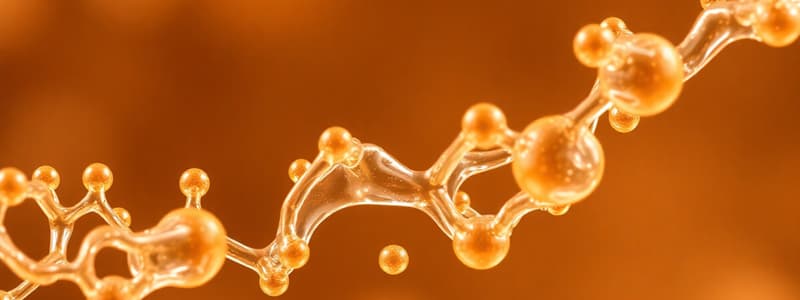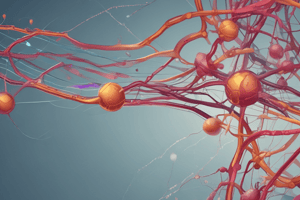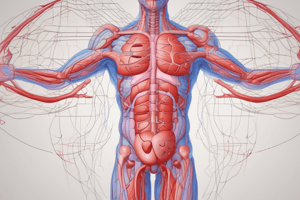Podcast
Questions and Answers
What is proalbumin also known as after the signal peptide is removed?
What is proalbumin also known as after the signal peptide is removed?
- Insulin
- Albumin
- Prealbumin (correct)
- Hexapeptide
What happens to proalbumin after a hexapeptide is cleaved?
What happens to proalbumin after a hexapeptide is cleaved?
- It degrades into amino acids.
- It is converted back into a signal peptide.
- It transforms into the active form, albumin. (correct)
- It becomes an inactive form.
Which statement is true regarding the transformation from proalbumin to albumin?
Which statement is true regarding the transformation from proalbumin to albumin?
- The signal peptide remains attached in albumin.
- Proalbumin can be synthesized directly into albumin.
- Hexapeptide removal activates albumin. (correct)
- Proalbumin is a precursor to insulin.
What is the role of the signal peptide in the context of proalbumin?
What is the role of the signal peptide in the context of proalbumin?
What is the primary limitation of albumin in assessing liver function?
What is the primary limitation of albumin in assessing liver function?
Which protein is formed after both the removal of the signal peptide and the cleavage of the hexapeptide?
Which protein is formed after both the removal of the signal peptide and the cleavage of the hexapeptide?
Which of the following substances does albumin NOT bind to?
Which of the following substances does albumin NOT bind to?
Why might albumin binding lead to potential drug-drug interactions?
Why might albumin binding lead to potential drug-drug interactions?
Which metal is known to bind with albumin?
Which metal is known to bind with albumin?
What defines the significance of bilirubin in the context of albumin binding?
What defines the significance of bilirubin in the context of albumin binding?
What is the primary role of albumin in drug transport?
What is the primary role of albumin in drug transport?
What happens when two drugs bind to the same site on albumin?
What happens when two drugs bind to the same site on albumin?
Which form of a drug is able to leave the plasma and enter tissues?
Which form of a drug is able to leave the plasma and enter tissues?
What are the two forms in which drugs exist due to albumin's role?
What are the two forms in which drugs exist due to albumin's role?
The presence of which substance in the bloodstream primarily affects drug transport?
The presence of which substance in the bloodstream primarily affects drug transport?
Which plasma protein is NOT mentioned as being affected by polymorphisms?
Which plasma protein is NOT mentioned as being affected by polymorphisms?
What best describes ABO blood grouping?
What best describes ABO blood grouping?
Which of the following plasma proteins is specifically associated with immune functions?
Which of the following plasma proteins is specifically associated with immune functions?
What is the role of transferrin in the body?
What is the role of transferrin in the body?
Which plasma protein has functions related to inflammation and tissue repair?
Which plasma protein has functions related to inflammation and tissue repair?
How does smoking affect elastase activity in individuals with certain conditions?
How does smoking affect elastase activity in individuals with certain conditions?
What is the consequence of increased oxidization of alpha1-antitrypsin due to smoking?
What is the consequence of increased oxidization of alpha1-antitrypsin due to smoking?
What is a critical effect of smoking on individuals already suffering from specific conditions?
What is a critical effect of smoking on individuals already suffering from specific conditions?
Which of the following best summarizes the impact of smoking on alpha1-antitrypsin?
Which of the following best summarizes the impact of smoking on alpha1-antitrypsin?
What is a long-term effect of smoking on individuals with pre-existing conditions?
What is a long-term effect of smoking on individuals with pre-existing conditions?
What is the expected band pattern of proteins in liver diseases?
What is the expected band pattern of proteins in liver diseases?
Which proteins are synthesized elsewhere in cases of liver diseases?
Which proteins are synthesized elsewhere in cases of liver diseases?
Why are proteins generally low in liver disease conditions?
Why are proteins generally low in liver disease conditions?
What happens to the gamma globulins in liver disease?
What happens to the gamma globulins in liver disease?
What remains consistent in the protein levels of a patient with liver disease?
What remains consistent in the protein levels of a patient with liver disease?
Flashcards
Polymorphism in Plasma Proteins
Polymorphism in Plasma Proteins
Variations in a gene that result in different forms of a protein. This is common in many plasma proteins.
ABO Blood Grouping
ABO Blood Grouping
A specific example of polymorphism affecting plasma proteins. This group system determines blood type.
Alpha 1-Antitrypsin
Alpha 1-Antitrypsin
A plasma protein that inhibits the enzyme elastase, protecting tissues from damage.
Haptoglobin
Haptoglobin
Signup and view all the flashcards
Transferrin
Transferrin
Signup and view all the flashcards
What is the role of albumin in the body?
What is the role of albumin in the body?
Signup and view all the flashcards
Proalbumin
Proalbumin
Signup and view all the flashcards
What substances does albumin bind to?
What substances does albumin bind to?
Signup and view all the flashcards
Albumin
Albumin
Signup and view all the flashcards
Signal Peptide
Signal Peptide
Signup and view all the flashcards
Why is albumin not useful for assessing short-term liver function?
Why is albumin not useful for assessing short-term liver function?
Signup and view all the flashcards
What is bilirubin?
What is bilirubin?
Signup and view all the flashcards
Protein Cleavage
Protein Cleavage
Signup and view all the flashcards
Hexapeptide
Hexapeptide
Signup and view all the flashcards
What happens when bilirubin levels are high?
What happens when bilirubin levels are high?
Signup and view all the flashcards
Drug-Drug Interactions on Albumin
Drug-Drug Interactions on Albumin
Signup and view all the flashcards
Free Form of a Drug
Free Form of a Drug
Signup and view all the flashcards
Bound Form of a Drug
Bound Form of a Drug
Signup and view all the flashcards
Albumin as a Drug Transporter
Albumin as a Drug Transporter
Signup and view all the flashcards
Competition for Binding Sites on Albumin
Competition for Binding Sites on Albumin
Signup and view all the flashcards
Elastases
Elastases
Signup and view all the flashcards
Oxidation
Oxidation
Signup and view all the flashcards
Emphysema
Emphysema
Signup and view all the flashcards
How smoking worsens lung disease
How smoking worsens lung disease
Signup and view all the flashcards
Protein Electrophoresis
Protein Electrophoresis
Signup and view all the flashcards
Gamma Globulins
Gamma Globulins
Signup and view all the flashcards
Liver Disease and Protein Synthesis
Liver Disease and Protein Synthesis
Signup and view all the flashcards
Low Protein Bands except for Gamma Globulins
Low Protein Bands except for Gamma Globulins
Signup and view all the flashcards
Abnormal Protein Electrophoresis in Liver Disease
Abnormal Protein Electrophoresis in Liver Disease
Signup and view all the flashcards
Study Notes
Biochemistry - Plasma Proteins
- Synthesis: Most plasma proteins (albumin and globulins) are synthesized in the liver. The only exception are gamma globulins, which are immunoglobulins produced by mature B lymphocytes in the bone marrow, spleen, and lymph nodes.
- Preproproteins: Plasma proteins are initially synthesized as preproproteins (immature forms). This inactive form protects the producing tissue/cells. This is necessary because it keeps the protein in an inactive form until needed, preventing damage to those tissues where they don't act.
- Post-translational modifications: Preproproteins undergo various post-translational modifications before becoming mature proteins. This includes signaling processes (2 for preproproteins, 1 for proproteins).
- Time of synthesis: Time taken for synthesis varies greatly depending on the type of protein, from 30 minutes to several hours.
- Glycoproteins: Most plasma proteins are glycoproteins (N- or O-linked), except for albumin.
- Polymorphism: Plasma proteins exhibit polymorphism, meaning they have variations in their structure.
- Half-lives: The half-life of each plasma protein varies depending on its type and function, and can change upon binding to other molecules. Half-life is determined by isotope labeling studies.
- Half-life in diseases: Diseases such as protein-losing gastroenteropathy can affect the half-life of plasma proteins. For example, in Crohn's disease, the half-life of albumin is reduced by one day.
Polymorphism
- Definition: A mutation in a gene sequence that alters proteins slightly is called polymorphism.
- Effect on Proteins: These mutations can either improve a protein's functions, reduce its efficiency, or have no impact at all.
- Population Frequency: When the mutation is present in more than 1% of a population, it is considered a polymorphism. This includes polymorphisms in multiple plasma proteins like alpha 1-antitrypsin, haptoglobin, transferrin, ceruloplasmin, and immunoglobulins.
- ABO example: The ABO blood grouping system is the best-known example of a polymorphism.
- Disease Connection: Polymorphism does not always cause disease.
General and Specific Functions of Plasma Proteins
- Nutritive role: Broken down for energy.
- pH maintenance: Proteins buffer the blood's pH due to amide and carboxyl groups.
- Viscosity: Increase blood viscosity (even albumin - though not a glycoprotein).
- Osmotic pressure: Maintain blood osmotic pressure.
- Specific functions:
- Enzymes: Rennin, coagulation factors, lipases
- Immunoglobulins: Humoral immunity
- Coagulation factors: Blood coagulation
- Hormones: Erythropoietin
- Transport proteins: Transferrin, thyroxine-binding globulin, apolipoproteins.
Starling Forces
- Blood pressure: Blood pressure pushes water out of vessels.
- Oncotic pressure: Opposing force that keeps water around proteins.
- Fluid Movement: Normal fluid balance occurs at different ends of capillaries (arterial & venous) due to difference in hydrostatic and oncotic pressure.
- Edema: Excess fluid accumulation in tissues might occur if more fluid leaves than returns.
Acute-Phase Proteins
- Definition: Dramatic increases in some protein levels during inflammation, tissue damage, or cancer (0.5-1000-fold increase).
- Mechanism: Cytokines (e.g., interleukin-1, IL-1) activate NF-kB, leading to increased protein production.
- Positive acute-phase proteins: Their concentrations increase during inflammation. Examples include C-reactive protein, alpha-1-antitrypsin, haptoglobin, and fibrinogen
- Negative acute-phase proteins: Their concentrations decrease during inflammation. Examples include pre-albumin, albumin, and transferrin.
Prealbumin (Transthyretin)
- Role: Transports thyroid hormones T3 and T4. It migrates ahead of albumin on electrophoresis gels.
- Properties: Small glycoprotein, low blood levels (0.25 g/L), short half-life (2 days)
- Clinical Usefulness: Useful in diagnosing diseases or poor protein nutrition.
Alpha 1-Antitrypsin
- Role: Inhibits trypsin-like enzymes that break down proteins.
- Functions: Protects tissues, especially lungs, from elastase damage, which is important in chronic inflammation.
- Mechanism: Inhibits elastase, an enzyme that breaks down lung tissue.
- Genetic deficiency: Causes emphysema. The PiZZ genotype is associated with high risk of emphysema.
- Oxidation: Smoking oxidizes Met-358, rendering it unable to inhibit elastase effectively.
Alpha-1-Antitrypsin Deficiency and Emphysema
- Genetic Issues: Individuals with the ZZ genotype have severely reduced Alpha1-antitrypsin activity, leading to an increased risk of lung damage and emphysema.
- Oxidative Stress Smoking increases oxidative stress (in the lungs) that further damages the A1AT protein.
- Rapid Disease progression: Due to the severe deficiency and oxidative stress, patients with the PiZZ genotype exhibit rapid disease progression leading to severe complications and may not survive.
Alpha-2 Globulins (Haptoglobin)
- Function: Binds to free hemoglobin to stop the loss of it in the urine.
- Half-life: 5 days, becomes shorter (90 minutes) once bound to hemoglobin.
- Clinical significance: It is part of the iron recycling process of the body.
Ceruloplasmin
- Role: Copper transport, acts as a copper carrier and regulates copper levels in blood, important for cellular health.
- Structure: 160 kDa copper-containing glycoprotein.
3-Beta Globulins (C-Reactive Protein, CRP)
- Function: Part of the body's immune response, works against bacteria, and helps prevent infections
- Clinical significance: A marker for inflammation, used in diagnosis. Elevated CRP levels indicate inflammation and other issues like acute rheumatic fever.
- Monitoring marker: CRP reaches peak levels around 48 hours after acute inflammation onset.
Diseases affecting Plasma proteins
- Hypoalbuminemia: Low albumin caused by liver or kidney problems (e.g., cirrhosis, renal failure)
- Hyperalbuminemia: High albumin typically associated with dehydration or cancer.
- Other issues affecting protein synthesis in liver and other relevant conditions: These changes lead to changes in other protein bands.
- Gamma Globulin bands: Increased gamma globulin band indicates cancer.
- Renal failure: Lower concentration of specific protein bands which negatively affects the body due to loss of protein in circulation.
- Drug interactions: Some drugs compete for the same binding sites on albumin, potentially altering their effects.
Studying That Suits You
Use AI to generate personalized quizzes and flashcards to suit your learning preferences.




